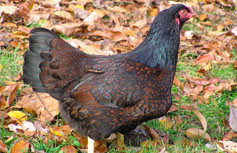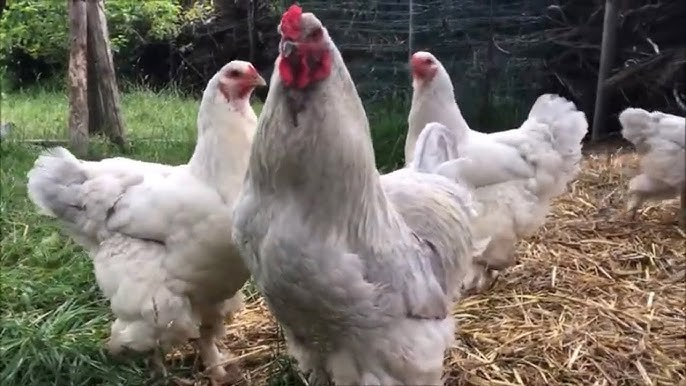Have you ever dreamed of collecting eggs that come in dazzling shades of blue, green, or even pink? Instead of the usual white or brown eggs, imagine waking up to a basket filled with nature’s very own rainbow. The best part? These vibrant eggs are not painted or dyed—they are a natural genetic gift from certain unique chicken breeds.
Raising chickens that lay colorful eggs adds excitement and beauty to your flock and offers a rewarding experience for poultry enthusiasts. In this guide, you’ll learn everything you need to know about the fascinating genetics behind egg colors, how to select the right breeds, and how to care for your colorful flock so they thrive and produce those magical eggs.
If you want to transform your backyard into a colorful egg paradise, this step-by-step guide is just what you need!
Part 1: Understanding the Genetics Behind Colored Eggs
1.1 The Science of Egg Color (Approx. 400 words)
Eggshell color is determined genetically. During the formation of the egg inside the hen, pigments are deposited onto the shell that determine its final color.
- Blue Eggs
The blue color results from a pigment called oocyanin, which is deposited throughout the eggshell during its formation. Unlike brown eggs, the blue pigment permeates the entire shell, giving a vibrant and consistent color. - Green Eggs
Green eggs occur when the blue pigment combines with brown pigments deposited on the outer shell, creating various shades of green. The depth of green can range from pale mint to deep olive, depending on the breed and genetics. - Pink Eggs
Some rare breeds lay eggs with a pinkish tint. This is typically a softer, subtle hue, and it’s often a combination of light brown pigments with other genetic factors influencing the shell color.
Understanding these pigments is crucial for anyone aiming to raise a flock that produces eggs in these beautiful colors naturally.
1.2 Choosing the Right Breeds (Approx. 400 words)
If you want to start your colorful egg journey, selecting the right chicken breeds is your first step.
- Araucana
Originating from Chile, Araucanas are famous for their striking blue eggs and distinctive ear tufts. They are hardy birds known for their unique appearance and excellent egg color. - Ameraucana
Developed in the United States, Ameraucanas are closely related to Araucanas but without ear tufts. They lay eggs ranging from blue to green hues and have a bearded and muffed facial appearance. - Easter Egger
Not a breed but a hybrid, Easter Eggers can lay eggs in a wide range of colors including blue, green, and pink. They are very popular among backyard poultry keepers for their colorful variety. - Madagascar Game Fowl
A rare breed that is known to lay eggs with a pinkish hue, adding a unique shade to your egg collection.
By incorporating these breeds into your flock, you can enjoy a natural palette of eggs all year round.
Part 2: Setting Up Your Flock for Success

2.1 Creating the Perfect Environment (Approx. 400 words)
Your chickens need the right environment to be healthy and productive.
- Secure Coop
Ensure your coop is predator-proof and provides adequate space for each chicken to reduce stress and encourage laying. The recommended minimum space is about 4 square feet per bird inside the coop. - Nesting Boxes
Provide clean, comfortable nesting boxes lined with straw or wood shavings. Aim for one box per 3-4 hens to reduce competition. - Free-Roaming Space
Chickens benefit from access to outdoor runs or free-range areas where they can forage, exercise, and engage in natural behaviors. - Proper Lighting
Chickens require about 14-16 hours of light daily for optimal laying. Consider supplemental lighting during short winter days to maintain egg production.
2.2 Balanced Nutrition and Hydration (Approx. 400 words)
Diet plays a vital role in egg color intensity and production.
- Layer Feed
Provide a high-quality commercial layer feed formulated with sufficient calcium, protein, and essential vitamins. - Natural Supplements
Supplement their diet with leafy greens, grains, and protein sources like mealworms to enrich nutrition. - Calcium Sources
Crushed oyster shells or eggshells provide additional calcium for strong eggshell formation. - Fresh Water
Ensure constant access to clean, fresh water to keep hens hydrated and healthy.
2.3 Health Maintenance and Care (Approx. 300 words)
Healthy chickens lay better eggs. Prioritize their wellbeing with:
- Regular Health Checks
Monitor your flock for signs of illness, parasites, or distress. - Parasite Control
Implement regular treatments for mites, lice, and worms. - Cleanliness
Keep the coop and nesting boxes clean to prevent disease. - Vaccinations
Stay updated on recommended vaccinations for your area.
2.4 Patience and Observation (Approx. 100 words)
Most hens begin laying eggs between 5 to 6 months of age. Be patient as your flock matures and observe their behavior to ensure they are healthy and ready to start laying.
The Joy of Collecting Colorful Eggs (Approx. 200 words)
Collecting eggs in a variety of natural colors adds fun and beauty to your daily routine. Imagine gifting friends and family a basket filled with blue, green, and pink eggs—a delightful surprise and a conversation starter.
Raising colorful egg layers also supports biodiversity by preserving rare and heritage breeds, contributing to sustainable farming practices.
Common Mistakes and How to Avoid Them (Approx. 200 words)
- Ignoring Breed Genetics
Not all chickens lay colored eggs. Ensure you select breeds genetically predisposed to colorful egg laying. - Poor Nutrition
Lack of proper nutrition can dull eggshell color and reduce laying frequency. - Overcrowding
Crowded conditions stress hens, impacting their health and egg production. - Inadequate Lighting
Too little light results in fewer eggs or no laying at all.
Avoid these pitfalls by planning carefully and providing optimal care.
Seasonal and Regional Tips (Approx. 150 words)
- Winter Care
Shorter days reduce egg laying; use supplemental lighting and ensure warmth. - Algerian Context
Choose breeds that tolerate local climate extremes. Garlic, a staple in Algerian markets, can be used in natural remedies for chicken health. - Hydration During Hot Seasons
In warm climates, keep fresh water plentiful to prevent heat stress.
🧰 Tools and Materials Checklist
- 🐔 Chicken coop with nesting boxes
- 🥣 High-quality layer feed
- 💧 Clean water containers
- 🧹 Cleaning tools for coop maintenance
- 🌞 Supplemental lighting (optional)
- 🐛 Parasite control supplies
❓ Frequently Asked Questions (FAQs)
Q: Which chicken breeds lay blue eggs?
A: Araucana and Ameraucana are the most well-known blue egg layers.
Q: Can chickens lay multiple colored eggs?
A: Generally, individual hens lay eggs of a consistent color, but mixed flocks produce a colorful assortment.
Q: How long do hens typically lay eggs?
A: Most hens lay actively for 2-3 years, after which production declines.
Q: Does diet affect eggshell color?
A: Yes, a balanced diet rich in calcium and nutrients helps maintain vibrant shell colors.
Encouraging Conclusion
Raising chickens that lay colorful eggs is a delightful way to enrich your farm or backyard flock. It blends science, nature, and joy into one fulfilling hobby. Whether you’re a beginner or experienced poultry keeper, the magic of collecting rainbow eggs is within your reach.
Have you tried raising colorful egg layers? Share your stories and tips below! And if you found this guide helpful, please share it with friends and fellow chicken enthusiasts to spread the joy of colorful eggs!
Recommended External Resources (for Natural Anchor Texts)
- Boost your immune system with garlic
- Natural treatments for sinus infections
- Garlic’s antifungal properties
https://www.backyardchickens.com/articles/breeds-that-lay-blue-eggs.62018/
Recommended anchor text: breeds that lay blue eggs naturally
https://www.thespruce.com/why-do-chickens-lay-different-colored-eggs-3017310
Recommended anchor text: why chickens lay different colored eggs
https://www.poultrykeeper.com/articles/chicken-nutrition-feeding-guide/
Recommended anchor text: complete chicken nutrition and feeding guide


order amoxicillin generic – https://combamoxi.com/ amoxicillin price
fluconazole 100mg without prescription – https://gpdifluca.com/ diflucan 200mg brand
order cenforce 50mg online cheap – https://cenforcers.com/# order cenforce without prescription
cialis 5mg 10mg no prescription – site cialis with out a prescription
what is tadalafil made from – https://strongtadafl.com/# where can i buy cialis online in australia
buy cheap viagra blog – strong vpls cheap viagra tablets
The vividness in this piece is exceptional. this
This website really has all of the low-down and facts I needed there this thesis and didn’t identify who to ask. https://buyfastonl.com/isotretinoin.html
More posts like this would add up to the online play more useful. https://ursxdol.com/levitra-vardenafil-online/
I couldn’t resist commenting. Warmly written! https://prohnrg.com/product/diltiazem-online/
This is the make of delivery I unearth helpful. apicil demande de prise en charge lasix exceptionnel
Palatable blog you procure here.. It’s intricate to espy elevated calibre belles-lettres like yours these days. I really recognize individuals like you! Rent guardianship!! https://ondactone.com/product/domperidone/
This is a topic which is in to my fundamentals… Numberless thanks! Unerringly where can I notice the contact details due to the fact that questions?
buy toradol 10mg pills
The thoroughness in this draft is noteworthy. http://zqykj.cn/bbs/home.php?mod=space&uid=302506
where to buy dapagliflozin without a prescription – dapagliflozin 10 mg cost purchase dapagliflozin online
xenical tablet – orlistat for sale xenical 60mg oral
More posts like this would prosper the blogosphere more useful. https://experthax.com/forum/member.php?action=profile&uid=124849
You can keep yourself and your ancestors close being wary when buying panacea online. Some druggist’s websites operate legally and provide convenience, reclusion, cost savings and safeguards for purchasing medicines. buy in TerbinaPharmacy https://terbinafines.com/product/haldol.html haldol
More delight pieces like this would create the интернет better. TerbinaPharmacy
This is a topic which is near to my verve… Numberless thanks! Faithfully where can I find the acquaintance details in the course of questions?
https://t.me/s/iGaming_live/4866